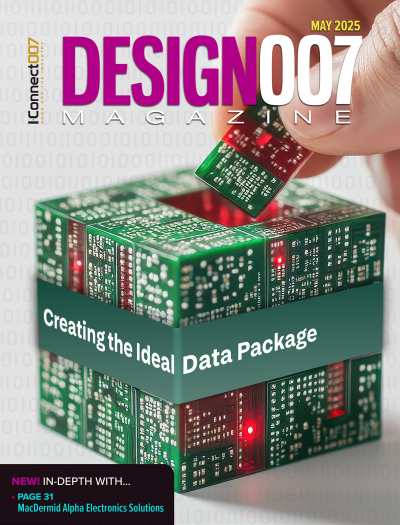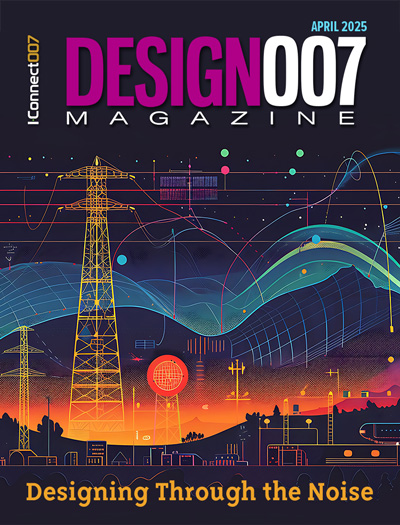-

- News
- Books
Featured Books
- design007 Magazine
Latest Issues
Current Issue
All About That Route
Most designers favor manual routing, but today's interactive autorouters may be changing designers' minds by allowing users more direct control. In this issue, our expert contributors discuss a variety of manual and autorouting strategies.

Creating the Ideal Data Package
Why is it so difficult to create the ideal data package? Many of these simple errors can be alleviated by paying attention to detail—and knowing what issues to look out for. So, this month, our experts weigh in on the best practices for creating the ideal design data package for your design.

Designing Through the Noise
Our experts discuss the constantly evolving world of RF design, including the many tradeoffs, material considerations, and design tips and techniques that designers and design engineers need to know to succeed in this high-frequency realm.
- Articles
- Columns
Search Console
- Links
- Media kit
||| MENU - design007 Magazine
Beyond Design: DDR3/4 Fly-by vs. T-topology Routing
June 1, 2016 | Barry Olney, In-Circuit Design Pty LtdEstimated reading time: 1 minute
JEDEC introduced fly-by topology in the DDR3 specification for the differential clock, address, command and control signals. The advantage of fly-by topology is that it supports higher-frequency operation, reduces the quantity and length of stubs and consequently improves signal integrity and timing on heavily loaded signals. Fly-by topology also reduces simultaneous switching noise (SSN) by deliberately causing flight-time skew, between the address group and the point-to-point topology signals, of the data groups. To account for this skew, the DDR3/4 controller supports write leveling. The controller must add the write leveling delays to each byte lane to maintain the strobe to clock requirement at the SDRAMs.
T-topology can be challenging to route, particularly double T-topology with four back-to-back SDRAMs, but it can be advantageous when using multi-die packages. The fly-by topology used in Figure 3 is much easier to route but does not work well with high-capacitance loads, such as LPDDR3 DDP (double die package) and QDP (quad die package) devices. IC fabricators basically arrange dies in parallel to increase package density which can also increase input capacitance by up to four times. Excessive ring-back is often present in the first few nodes of the daisy chain.
This is the reason why the T-topology was developed. However, if you are supporting only SDP (single die package) devices, then the fly-by is the most straightforward approach. It doesn't matter which topology you use, though—both fly-by and double T-topologies should work fine. If you are using a DDP device, then double-T topology works better than fly-by in terms of delivering a better system margin.
During a write cycle, using the fly-by topology, data strobe groups are launched at separate intervals to coincide with the clock arriving at memory components on the SODIMM or PCB, and must meet the timing parameter between the memory clock and DQS defined as tDQSS of ± 0.25 tCK. The PCB design process can be simplified using the leveling feature of the DDR3/4. The fly-by, daisy chain topology increases the complexity of the controller design to achieve leveling but fortunately, greatly improves performance and eases board layout for DDR3/4 designs.
To read this entire article, which appeared in the April 2016 issue of The PCB Design Magazine, click here.
Suggested Items
Cadence AI Autorouter May Transform the Landscape
06/19/2025 | Andy Shaughnessy, Design007 MagazinePatrick Davis, product management director with Cadence Design Systems, discusses advancements in autorouting technology, including AI. He emphasizes a holistic approach that enhances placement and power distribution before routing. He points out that younger engineers seem more likely to embrace autorouting, while the veteran designers are still wary of giving up too much control. Will AI help autorouters finally gain industry-wide acceptance?
Beyond Design: The Metamorphosis of the PCB Router
06/18/2025 | Barry Olney -- Column: Beyond DesignThe traditional PCB design process is often time-consuming and labor-intensive. Routing a complex PCB layout can consume up to 30% of a designer’s time, and addressing this issue is not straightforward. We have all encountered this scenario: You spend hours setting the constraints and finally hit the Go button, only to be surprised by the lack of visual appeal and the obvious flaws in the result.
Robust AI Demand Drives 6% QoQ Growth in Revenue for Top 10 Global IC Design Companies in 1Q25
06/15/2025 | TrendForceTrendForce’s latest investigations reveal that 1Q25 revenue for the global IC design industry reached US$77.4 billion, marking a 6% QoQ increase and setting a new record high. This growth was fueled by early stocking ahead of new U.S. tariffs on electronics and the ongoing construction of AI data centers around the world, which sustained strong chip demand despite the traditional off-season.
Cadence Advances Design and Engineering for Europe’s Manufacturers on NVIDIA Industrial AI Cloud
06/13/2025 | Cadence Design Systems, Inc.At NVIDIA GTC Paris, Cadence announced it is providing optimized solutions for the world’s first industrial AI cloud in collaboration with NVIDIA.
Zuken Autorouters Embrace Collaborative AI
06/12/2025 | Andy Shaughnessy, Design007 MagazineMaybe you’ve never liked autorouters; if so, you’re not alone. As Andy Buja, Zuken’s technical account manager for PCB Solutions, admits, autorouters are not perfect. But today’s autorouters allow designers a greater level of control than ever before, especially routers that incorporate collaborative AI.


